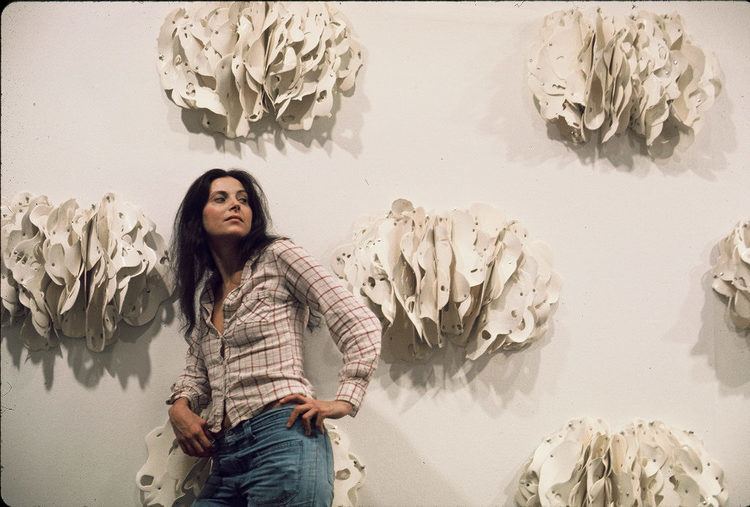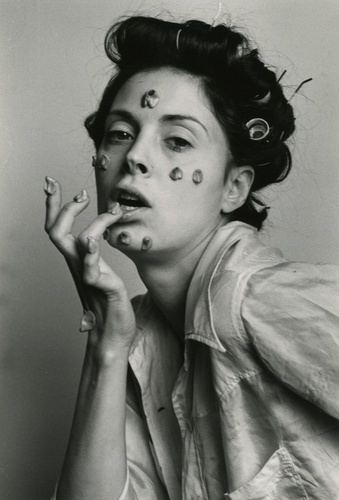Nationality American Name Hannah Wilke | Role Photographer | |
 | ||
Full Name Arlene Hannah Butter Notable work S.O.S. — Starification Object Series (1974)Intra-Venus (1992–1993) Died January 28, 1993, New York City, New York, United States Education Tyler School of Art (1962) Books Hannah Wilke: Selected Work 1960-1992 Awards Guggenheim Fellowship for Creative Arts, US & Canada Known for Sculpture, Photography, Body art, Video art | ||
Hannah wilke gestures 1974 excerpt
Hannah Wilke (born Arlene Hannah Butter; March 7, 1940 – January 28, 1993) was an American painter, sculptor, photographer, video artist and performance artist. Wilke's work is known for exploring issues of feminism, sexuality and femininity.
Contents
- Hannah wilke gestures 1974 excerpt
- Hannah Wilke Body Language
- Biography
- Early work
- Body art
- Death and Intra Venus
- Pose and narcissism
- Critical recognition
- Group exhibitions
- Solo exhibitions
- AccomplishmentsAwards
- Museum and Gallery Holdings
- References

Hannah Wilke – Body Language
Biography
Hannah Wilke was born in 1940 in New York City to Jewish parents; her grandparents were Eastern European immigrants. In 1962, she received a Bachelor of Fine Art and a Bachelor of Science in Education from the Tyler School of Art, Temple University, Philadelphia. She taught art in several high schools and joined the faculty of the School of Visual Arts, New York, where she taught sculpture and ceramics from 1974–1991. From 1969 to 1977, Wilke was in a relationship with the American Pop artist, Claes Oldenburg, and they lived, worked and traveled together during that time. Wilke's work was exhibited nationally and internationally throughout her life and continues to be shown posthumously. Solo exhibitions of her work were first shown in New York and Los Angeles in 1972. Her first full museum exhibition was held at the University of California, Irvine, in 1976, and her first retrospective at the University of Missouri in 1989. Posthumous retrospectives were shown in Copenhagen, Helsinki, and Malmo, Sweden in 2000 and at the Neuberger Museum of Art in 2009. Since her death, Wilke's work has been shown in solo gallery shows, group exhibitions, and several surveys of women's art, including WACK! (www.moca.org) and Elles (www.pompidou.fr).
Early work

Wilke first gained renown with her "vulval" terra-cotta sculptures in the 1960s. Her sculptures, first exhibited in New York in the late 1960s, are often mentioned as some of the first explicit vaginal imagery arising from the women's liberation movement, and they became her signature form which she made in various media, colors and sizes, including large floor installations, throughout her life. Some of her mediums included clay, chewing gum, kneaded erasers, laundry lint and latex. The use of unconventional materials is typical of feminist art, because traditionally women did not have access to art supplies. These sculptures were an innovative example of eroticism using a style that combined post-minimalism and feminist aesthetics. A consummate draftswoman, Wilke created numerous drawings, beginning in the early 1960s and throughout her life. In a review of Wilke's drawings at Ronald Feldman Fine Arts in 2010, Thomas Micchelli writes in The Brooklyn Rail: "at her core, she was a maker of things […] an artist whose sensuality and humor are matched by her formal acumen and tactile rigor." She performed live and videotaped performance art, beginning in 1974 with Hannah Wilke Super-t-Art, a live performance at the Kitchen, New York, which she also made into an iconic photographic work. The performance art Wilke did evokes the likes of Simone Forti, Trisha Brown and Yvonne Rainer. The sculptural art Wilke created, with its unconventional materials and feminist narratives also relates to the likes of Louise Bourgeois, Eva Hesse, Alina Szapocznikow and Niki de St Phalle.
Body art

In 1974, Wilke began work on her photographic body art piece S.O.S — Starification Object Series in which she merged her minimalist sculpture and her own body by creating tiny vulval sculptures out of chewing gum and sticking them to herself. She then had herself photographed in various pin-up poses, providing a juxtaposition of glamour and something resembling tribal scarification. Wilke has related the scarring on her body to an awareness of the Holocaust. These poses exaggerate and satirize American cultural values of feminine beauty and fashion and also hint an interest in ceremonial scarification. The 50 self-portraits were originally created as a game, "S.O.S.Starificaion Object Series: An Adult Game of Mastication", 1974–75, which Wilke made into an installation that is now in the Centre Pompidou, Paris. She also performed this piece publicly in Paris in 1975, having audience members chew the gum for her before she sculpted them and placed them on papers that she hung on the wall. Wilke also used colored chewing gum as a medium for individual sculptures, using multiple pieces of gum to create a complex layering representing the vulva.
Wilke coined the term "performalist self-portraits" to credit photographers who assisted her, including her father (First Performalist Self-Portrait, 1942–77) and her sister, Marsie (Butter) Scharlatt (Arlene Hannah Butter and Cover of Appearances, 1954–77). The title of Wilke's photographic and performance work, So Help Me Hannah, 1979, was taken from a vernacular phrase from the 1930s and '40s and has been interpreted as playing off of the Jewish mother stereotype and referencing Wilke's relationship with her mother.
Besides Hannah Wilke Super-t-Art, 1974, other well-known performances in which Wilke used her body include Gestures, 1974; Hello Boys, 1975; Intercourse with… (audio installation)1974–1976; Intercourse with... (video) 1976; and Hannah Wilke Through the Large Glass performed at the Philadelphia Museum of Art in 1977.
Death and Intra-Venus
Hannah Wilke died in 1993 from lymphoma. Her last work, Intra-Venus (1992–1993), is a posthumously published photographic record of her physical transformation and deterioration resulting from chemotherapy and bone marrow transplant. The photographs, which were taken by her husband Donald Goddard whom she had lived with since 1982 and married in 1992 shortly before her death, confront the viewer with personal images of Wilke progressing from midlife happiness to bald, damaged, and resigned. Intra-Venus mirrors her photo diptych Portrait of the Artist with Her Mother, Selma Butter, 1978–82, which portrayed her mother's struggles with cancer and "having literally incorporated her mother, illness and all." Intra-Venus was exhibited and published posthumously partially in response to Wilke's feelings that clinical procedures hide patients as if dying was a "personal shame".
The Intra Venus works also include watercolor Face and Hand drawings, Brushstrokes, a series of drawings made from her own hair and the Intra Venus Tapes, a 16-channel videotape installation.
Pose and narcissism
In her work, Hannah Wilke often features herself as a posing glamour model. Her use of self in photography and performance art, however, has been interpreted as a celebration and validation of Self, Women, the Feminine, and Feminism. Conversely, it has also been described as an artistic deconstruction of cultural modes of female vanity, narcissism and beauty.
Wilke referred to herself as a feminist artist from the beginning. The art critic Ann-Sargent Wooster said that Wilke's identification with the feminist movement was confusing because of her beauty—her self-portraitures looked more like a Playboy centerfold than the typical feminist nudes. According to Wooster,
The problem Wilke faced in being taken seriously is that she was conventionally beautiful and her beauty and self-absorbed narcissism distracted you from her reversal of the voyeurism inherent in women as sex objects. In her photographs of herself as a goddess, a living incarnation of great works of art or as a pin-up, she wrested the means of production of the female image from male hands and put them in her own.
If critics found Wilke's beauty an impediment to understanding her work, this changed in the early 1990s when Wilke began documenting the decay of her body ravaged by lymphoma. Wilke's use of self-portraiture has been explored in detail in writing about her last photographic series, Intra Venus.
Wilke once answered the critics who commented on her body being too beautiful for her work by saying “People give me this bullshit of, ‘What would you have done if you weren’t so gorgeous?’ What difference does it make? ... Gorgeous people die as do the stereotypical ‘ugly.’ Everybody dies.”
Critical recognition
During her lifetime, Wilke was widely exhibited, and although controversial, received critical praise. However, until recently, museums were hesitant to acquire work by women artists who, including Wilke, engaged in protests decrying their lack of inclusion during the feminist movement of the 1970s. Wilke's work, with its confrontational use of female sexuality and the fact that it does not fit into a distinct genre or style, was in very few permanent collections when she was alive. Since her death, Wilke's work has been acquired into the permanent collections of The Museum of Modern Art, New York, the Whitney Museum of American Art, New York, Los Angeles County Museum of Art, Museum of Contemporary Art, Los Angeles, and in European museums such as the Centre Pompidou, Paris.
Group exhibitions
1972, American Women Artists, Hamburg, Germany
1973, Whitney Biennial, Whitney Museum of American Art, New York
1977, Contemporary Women: Consciousness and Content, Brooklyn Museum Art School, New York
1980, American Women Artists 1980, Museu de Arte Contemporanea, São Paulo
1988, Modes of Address: Language in Art Since 1960, Whitney Museum of American Art, New York
1993, Abject Art: Repulsion and Desire in American Art, Whitney Museum of American Art, New York
1995, Action/Performance and the Photograph, Allen Memorial Art Museum at Oberlin College, Oberlin (travelling exhibition)
1997, Identity Crisis: Self-Portraiture at the End of the Century, Milwaukee Art Museum, Milwaukee
2002, Tableaux Vivants, The Art of ‘LivingPictures’ in Photography, Film, and Video, Kunsthalle Wein, Vienna
2003, Pulse: Art, Healing and Transformation, Institute of Contemporary Art, Boston
2007, I Am Making Art: 4 Studies of the Artist’s Body, Centre d’Art Contemporain, Geneva
2007, WACK! Art and the Feminist Revolution, Geffen Contemporary at Museum of Contemporary Art, Los Angeles (travelling exhibition)
Solo exhibitions
1976, Fine Arts Gallery, University of California, Irvine
1978, PS1, Long Island, New York
1979, Washington Project for the Arts, Washington, DC
1989, Gallery 210, University of Missouri, St Louis
1994, Intra-Venus, Ronald Feldman Fine Arts, New York (travelling exhibition displaying photographs set out like the Stations of the Cross, showing her personal confrontation with her own death)
1998, Hannah Wilke, A Retrospective, Nikolaj Contemporary Art Center, Copenhagen (travelling exhibition)
2000, Uninterrupted Career: Hannah Wilke 1940–1993, Neue Gesellschaft für bildende Kunst, Berlin
Accomplishments/Awards
She received a Creative Artists Public Service Grant (1973); National Endowment for the Arts Grants (1987, 1980, 1979, 1976); Pollack-Krasner Foundation Grants (1992, 1987); a Guggenheim Fellowship (1982), and an International Association of Art Critics Award (1993).
Museum and Gallery Holdings
Brooklyn (Brooklyn Mus.)
Buffalo (Albright-Knox AG): Untitled (1976, chewing gum on cardboard)
Cincinnati (Cincinnati Museum of Art)
Des Moines, IA (Art Center)
Hartford, CT (Wadsworth Atheneum)
Helsinki (Helsinki Art Museum)
London (Tate Modern)
Los Angeles (Hammer Mus.)
Los Angeles (LA County MA)
Madrid (Mus. Nacional Centro de Arte Reina Sophia)
Minneapolis (Walker Arts Center)
Moscow (Pushkin Mus.)
New Haven (Yale University AG)
New York (Jewish Mus.): Venus Pareve (1982–1984)
New York (Metropolitan MA)
New York (Solomon R. Guggenheim Mus.): S.O.S Starification Object Series (1974, black and white photos)
New York (Whitney Mus. of American Art)
Oberlin, OH (Allen Memorial AM)
Paris (Centre Georges Pompidou)
Princeton, NJ (Princeton AM)
Providence (David Winton Bell Gal., Brown University): Chewing Gum (1975, collage)
Purchase, NY (Neuburger MA)
Reno (Nevada AM)
Tokyo (Metropolitan Mus. of Photography)
Waltham, MA (Rose AM)
